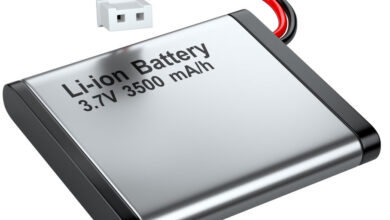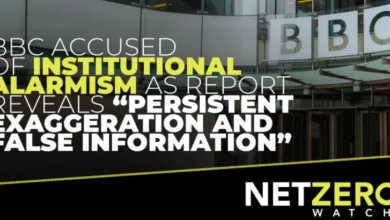EvapoTranspiration, the Unexplored Source of Climate Change – Watts Up With That?

By Charles Blaisdell, PhD ChE
Abstract
Evapotranspiration, ET, is a common term in agriculture used in connection with plant growth. ET: water going to the atmosphere from the earth’s surface. ET’s connection with climate change is described by the CRGW theory (def to follow) which starts out with a decrease in land ET (over time) that naturally (through the CRGW theory) leads to a global increase in ET. The localized land decrease in ET can occur in special parcels (urban heat islands,UHIs, deforestation, mining, etc) where the virgin land has been changed. The ET value of this change from virgin land is (in most cases) lost to time. Without an estimate of the change in ET over time the CRGW theory is not useful. This paper summarizes papers from Mazrooei et al. (2021) (1) and Lu Hao et al. (2021) (3) that present a creative method with NASA satellite data on local (urban Heat Islands, UHI’s) ET differences around the world. Their data (in climate change terms) show a wide range of ET that is correlated to the environment the UHI is in. Ariad UHI’s environments can have positive ET’s and wet environments have negative UHI ET’s. Mazrooei et al. (2021) uses a creative “bull’s eye” approach with satellite ET data. The UHI is in the center of the bull’s eye and the rural area in the outer ring. The ET from these two areas is used to calculate a precent difference in ET, showing a range of +10% to -50% and an average of -12% which may be a good estimate of the global UHI – virgin land difference.
The CRGW theory of ET related climate changes is: A localized ET decease (in a special parcel: UHI’s, deforestation, mining, etc.) = higher VPD (vapor pressure deficit) = air rising in a plume = less clouds or less reflective clouds = more sun = higher temperature and more evaporation of water = higher global ET: Cloud Reduction Global Warming, CRGW. In the CRGW theory the %ET/unit area difference between virgin land and special parcel remains about the same with time. What changes over time is the size of the special parcel (some albedo change may also occur). The result of this natural process can be seen in the current atmospheric “fingerprint” over time (1970 to 2020): Increasing temperature, increasing specific humidity, decreasing relative humidity, decreasing cloud fraction, and increasing VPD (vapor pressure deficit). The atmospheric “fingerprint” shows the end results of this theory but does not show the beginning ET decrease in a local area. We can see the current ET of a UHI but we will never know what the ET was before the UHI was there. The “fingerprint” is evidence that the sum total of all earths local (Special Parcel) ETs has decreased over the 1970 to 2020 period of time. The work of Mazrooei et al. (2021) (1) may be the closest we can estimate how much the ET of the earth has changed.
Introduction
Evapotranspiration, ET, is defined as the total amount water flux evaporated into the atmosphere from surface and plant (dew) Evaporation and plant Transpiration. ET is a term used in agriculture water management to aid in crop growth and is usually measured by monitoring soil moisture change over time and plant types. The units of measure are height of liquid water evaporated/unit time/area, mm/yr/m^2, etc. Atmospheric measurement of ET is best done by a “eddy covariance tower” (5) which uses relative humidity and temperature at several point to calculate local ET. Land/satellite-based ET calculation is quite complicated, see (4) and (12)for examples. The exploration of ET as a correlation to climate change is just beginning (7), (9), (11). The CRGW theory is only applicable to the period 1970 to present and uses the total global ET from land and oceans. Global ET vs time data currently has very short history, but significant progress is being made, (10). The limited data suggest global ET increasing over time. The following assumptions show that ET is related to specific Humidity, SH:
ET (global) = global upward water flux = (global %water in surface air) X (global air flow rate up).
(Note the horizontal air flow rate is (important in other ET equations) not in this equation because the %water is global and yearly, thereby averaging out all the horizontal ET effect.)
On a daily basis the air flow rate up can vary a lot; but, on a monthly or annual basis the average air flow rate up is rather constant.
Likewise:
Change in ET = change in atmospheric water + change in precipitation.
There is currently no detectable change in global precipitation.
Therefore, ET is proportional to SH
Global change in ET mm/yr ≈ Global change is Specific Humidity, SH g/kg(da)
SH change is a good estimate of ET change as long as the precipitation remains constant. This is the change (% or fraction) in SH or ET not the actual value.
Figure 1 shows the year-to-year increase in specific humidity, SH, suggesting that global ET is also increasing over time.
Figure 1 Specific Humidity, SH vs time from Climate Explorer (6).
The CRGW theory assumes that the difference between current and virgin land ET/unit area remains constant as the size of the special parcel increases. It is recognized that the albedo of the special parcel may also change (usually decrease) with time. From Dubal et al (2021) (15) data in Blaisdell (16) (estimate the global correction for albedo to be about 15% of the total albedo change. An albedo correction could be added to the CRGW but not discussed in this paper.
The CRGW theory is reversable. A local decrease in in ET results in a global increase in ET and temperature. But, an increase in local ET will result in a global decrease in ET and temperature.
Estimation of local %ET decrease.
The CRGW theory for climate change begins with a local-land decrease (or increase) in %ET (=% change in SH, Specific Humidity). The initial ET (and SH) of the current UHI’s area cannot be measured (the virgin land’s ET has been changed by cities, forest to crop, or mining) but the present day UHI’s ET and SH can be measured and the ET (and SH) of rural area around the UHI can also be measured. The difference between the UHI’s and Rural ET would be a good estimate of what change in ET (and SH) has occurred over time. New science from NASA satellites and Mazrooei’s et al.’s (2021) (1) clever procedure can estimate the initial change in %ET. Mazrooei et al.’s (2021) procedure (1) with small pixel data from NASA satellites that covers an existing urban land scape and a surrounding buffer area using a multivariable algorithm calculates the difference in ET of the city and the ET of the rural area around the city, see concept in Figure 2. The marked up Figure 2 is from SMAP Hydroblocks (8) surface ground moisture data, SGM, satellite annual data. On a daily basis SGM is nonlinear to ET (at high or very low levels of SGM ET does not change) yearly data is more linear.
Figure 2. Copyed from (8) app. SMAP Hydroblocks. The surface ground moisture, brown indicating low surface moisture light green is higher surface moisture.
Figure 2 has concept circles. Mazrooei et al.’s (1) paper captures NASA satellite data on about 12 variables for each area for calculation of ET. The Mazrooei uses a boundary area around (not circles) each city’s irregular area – see Mazrooei et al. (1) Figure 1 for examples. Mazrooei et al.’s (2021) (5) defines the following calculation from the ET data :
ET(delta) = ET(urban) – ET(non-urban) Eq 1
ET(lamda) = ET(urban)/ET(non-urban) Eq 2
For the CRGW theory %ET (=%SH) change is need:
%ET = ET(delta)/ET(non-urban) Eq 3
Data from Mazrooei et al. paper looked at over 2300 cites. Mazrooei et al. (2021) objective was water management and UHIs not climate change. Thanks to Mazrooei et al.’s attachment of supporting data, the calculation of %ET change between city and rural could be done on over 1500 UHIs.
Mazrooei et al. (2021) paper’s Figure 2 summarized their data. Mazrooei’s Figure 2 (Figure 3 below) sorting their findings by Koppen Climate Classification, KCC, a system that tries to take into account the many variables of water getting into the atmosphere: latitude, altitude, vegetation, dryness, wetness, snow, etc. A wide range of urban and rural ET values in units of mm(of water)/mo(or)yr, low of about 1 to a high of 140 mm/mo(or)yr over many classes of land scape is shown in Mazrooei et al.’s Figure 2 (now Figure 3) highlighting the effect of the KCC land type on urban and rural ET.
Figure 3. ET diversity globally and by landscape type from Mazrooei et al’s. (1) Figure 2.
While very informative this data was not intended for climate change modeling. Mazrooei et al. (2021) attached (to their paper) data that was used to estimate the initial %ET change needed for the CRGW model. Table 1 shows the results in %ET change between Urban and non Urban using Eq 3. Table 1 mirrors the Mazrooei et al.’s (1) Figure 3 results for KCC classification. For CRGW modeling the summation of all the data is needed, that number came out to be -12% ET change for all the UHIs in the study. At the present time this -12% change is the best estimate of global %ET change (change of present day UHI’s – virgin land) we have for the invisible initial ET change. The large number of cities and variety of climates suggest that Mazrooei et al.’s study may be representative of all the UHI’s on earth for an estimate of the global %ET change of all UHIs. Note that this %ET change is on a 24 hr/day annual basis – previous CRGW model (in Blaisdell (2)) will be changed from a 12 hr/day annual basis. Also note this ET data is on a constant area of land for all cities and rural areas not weighted for the specific urban area. To get the %ET change contribution to global climate change each %ET in Mazrooei et al.’s paper needs to be multiplied by the area of it’s city (that data was not available). The CRGW model will use the -12% ET and total area of Special parcels.

Table 1. %ET change of UHIs calculated from Mazrooei et al data.
Reading Mazrooei et al.’s paper is highly recommended. Some interesting data from the paper are:
- Not all UHI are the same, some have very high negative %ET change and some even have positive %ET. Mazrooei points out this is related to Arid nature of where the city is located:
- Most big cities have Higher (negative) %ET than the global average: Miami Florida = -41%, New York New York = -36%, and Paris France = -26.
- UHIs in Arid areas can put more water into the air than their surrounding rural area, Tucson Arizona = +11%.
- Mazrooei et al.’s technique could also be used on other land changes (deforestation, crop change, mining, etc)
Mazrooei et al.’s (1) highlighted two cities that had opposite ET(delta) Tucson Az (positive ET(delta) and Greensboro NC (negative ET(delta). The results are shown in Mazrooei et al.’s (1) Figure 7 with conclusions drawn around water management. The climate change variable %ET change for this data is shown in Figure 4.

Figure 4. %ET change for two very different cities Tucson in a desert climate and Greensboro in a humid highly vegetative climate. Data from Mazrooei et al.’s (1) Figure 7.
Ten years of data in Figure 4 show little change in %ET. That is expected for an urban or non urban setting as long as nothing is done to change the water run off rate per unit of area or the vegetation (albedo in general). What does change is the total ET (water) that goes into the atmosphere as the urban area size increased over time. Figure 4 does highlight the excellent quality of Marzooei et al.’s data.
Significance in the CRGW model
The average of Mazrooei et al.’s (1) data of -12% in the CRGW theory along with the cloud cover/VPD ratio of -7.5 (from Blaisdell (13)) and average plume size of 2x (from Blaisdell (14)) suggest CRGW theory can account for a significant part of the 1970 to 2020 observed temperature increase and the atmospheric finger print (Blaisdell (2)) (details not shown).
Discussion
The work by Mazrooei et al is a significant contribution to the exploration of ET in climate change. The invisible decrease in ET of special parcels (UHIs) is now estimated. Mazrooei et al.’s work proves that the (invisible) starting step of the CRGW theory is real, significant, and negative. The Mazrooei – NASA procedure is recommended for measuring the deforestation and mining ET. The CRGW model comes close to matching the atmospheric fingerprint: a strong suggestion that CRGW is a significant contributor to climate change.
CO2 is innocent but clouds are guilty.
Bibliography
1. “Urbanization Impacts on Evapotranspiration Across Various Spatio-Temporal Scales” (2021) by Amir Mazrooei, Meredith Reitz, Dingbao Wang, A. Sankarasubramanian web link Urbanization Impacts on Evapotranspiration Across Various Spatio‐Temporal Scales – Mazrooei – 2021 – Earth’s Future – Wiley Online Library
2. “An Unexplored Source of Climate Change: Land Evapotranspiration Changes Over Time.” (2023) By Charles Blaisdell web link An Unexplored Source of Climate Change: Land Evapotranspiration Changes Over Time. – Watts Up With That?
3. “Urbanization alters atmospheric dryness through land evapotranspiration” (2023) by Lu Hao Ge Sun, Xiaolin Huang, Run Tang, Kailun Jin, Yihan Lai, Dongxu Chen, Yaoqi Zhang, Decheng Zhou, Zong-Liang Yang, Lang Wang, Gang Dong & Wenhong Li web link Urbanization alters atmospheric dryness through land evapotranspiration | npj Climate and Atmospheric Science (nature.com)
4. “Operational Evapotranspiration Mapping Using Remote Sensing and Weather Datasets: A New Parameterization for the SSEB Approach†” (2013) by Gabriel B. Senay, Stefanie Bohms, Ramesh K. Singh, Prasanna H. Gowda, Naga M. Velpuri, Henok Alemu, James P. Verdin web link Operational Evapotranspiration Mapping Using Remote Sensing and Weather Datasets: A New Parameterization for the SSEB Approach – Senay – 2013 – JAWRA Journal of the American Water Resources Association – Wiley Online Library
5. BRIEF PRACTICAL GUIDE TO EDDY COVARIANCE FLUX MEASUREMENTS by Burba G. and D. Anderson web link EC_book-2010-poster.pdf (licor.com)
6. Climate Explorer web site Climate Explorer: Select a monthly field (knmi.nl) go to “Cloud Cover” or any other data set, for CC click “EUMETSAT CM-SAF 0.25° cloud fraction” click “select field” at top of page on next page enter latitude (-90 to 90) and longitude (-180 to 180) for whole earth. Raw data link is above the graph.
7. “Recent decline in the global land evapotranspiration trend due to limited moisture supply” (2010) by Martin Jung, Markus Reichstein, Philippe Ciais, Sonia I. Seneviratne, Justin Sheffield, Michael L. Goulden, Gordon Bonan, Alessandro Cescatti, Jiquan Chen, Richard de Jeu, A. Johannes Dolman, Werner Eugster, Dieter Gerten, Damiano Gianelle, Nadine Gobron, Jens Heinke, John Kimball, Beverly E. Law, Leonardo Montagnani, Qiaozhen Mu, Brigitte Mueller, Keith Oleson, Dario Papale, Andrew D. Richardson, web link Recent decline in the global land evapotranspiration trend due to limited moisture supply | Nature
8. “SMAP-HydroBlocks, a 30-m satellite-based soil moisture dataset for the conterminous US” (2021) by Noemi Vergopolan, Nathaniel W. Chaney, Ming Pan, Justin Sheffield, Hylke E. Beck, Craig R. Ferguson, Laura Torres-Rojas, Sara Sadri & Eric F. Wood web link SMAP-HydroBlocks, a 30-m satellite-based soil moisture dataset for the conterminous US | Scientific Data (nature.com)
9. Thermodynamics of climate change between cloud cover, atmospheric temperature and humidity (2021) by Víctor Mendoza, Marni Pazos, René Garduño & Blanca Mendoza web link Thermodynamics of climate change between cloud cover, atmospheric temperature and humidity | Scientific Reports (nature.com)
10. Ensemble of CMIP6 derived reference and potential evapotranspiration with radiative and advective components by Nels Bjarke (2023), Joseph Barsugli & Ben Livneh link Ensemble of CMIP6 derived reference and potential evapotranspiration with radiative and advective components | Scientific Data (nature.com)
11. Urban dry island phenomenon and its impact on cloud base level by R MORIWAKI, K WATANABE, K MORIMOTO _pdf (jst.go.jp)
12. Development of a Benchmark Eddy Flux Evapotranspiration Dataset for Evaluation of Satellite-Driven Evapotranspiration Models Over the CONUS by John M. Volk a (2023), Justin Huntington a, Forrest S. Melton b c, Richard Allen d e, Martha C. Anderson f, Joshua B. Fisher g, Ayse Kilic e, Gabriel Senay h, Gregory Halverson i, Kyle Knipper j, Blake Minor a, Christopher Pearson a, Tianxin Wang k, Yun Yang n, Steven Evett l, Andrew N. French m, Richard Jasoni a, William Kustas f web link Development of a Benchmark Eddy Flux Evapotranspiration Dataset for Evaluation of Satellite-Driven Evapotranspiration Models Over the CONUS – ScienceDirect
13. “VPD, Vapor Pressure Deficit a Correlation to Global Cloud Fraction?” By Charles Blaisdell (2024) web link VPD, Vapor Pressure Deficit a Correlation to Global Cloud Fraction? – Watts Up With That?
14. “Soundings, Weather Balloons, and Vapor Pressure Deficit” by Charles Blaisdell (2024) web link Soundings, Weather Balloons, and Vapor Pressure Deficit – Watts Up With That?
15. “Radiative Energy Flux Variation from 2001–2020” by Hans-Rolf Dübal (2021) and Fritz Vahrenholt web link: Atmosphere | Free Full-Text | Radiative Energy Flux Variation from 2001–2020 | HTML (mdpi.com)
16. “CO2 is Innocent but Clouds are Guilty. New Science has Created a “Black Swan Event”**” by Charles Blaisdell (2022) web link CO2 is Innocent but Clouds are Guilty. New Science has Created a “Black Swan Event”** – Watts Up With That?
Related







